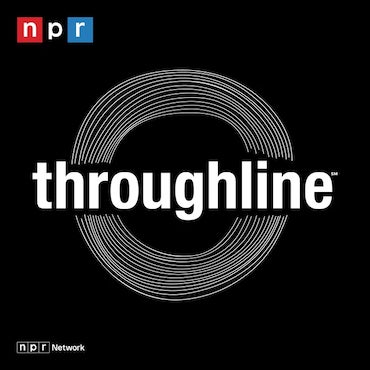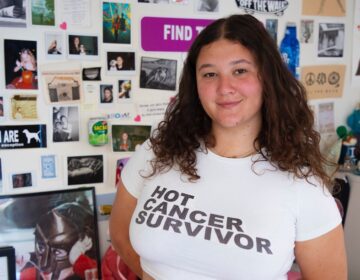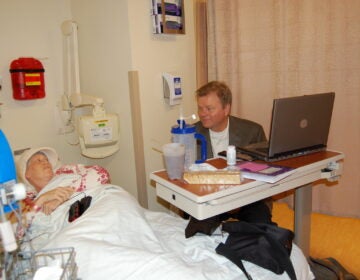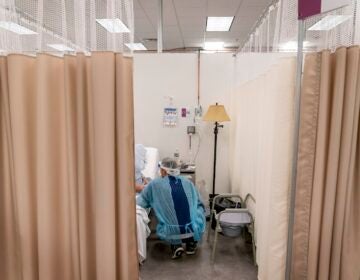How a clinical trial cured cancer — in some cases
A researcher’s experience as a patient motivated him to find cures. He focused on cancers caused by the human papillomavirus.
Listen 18:58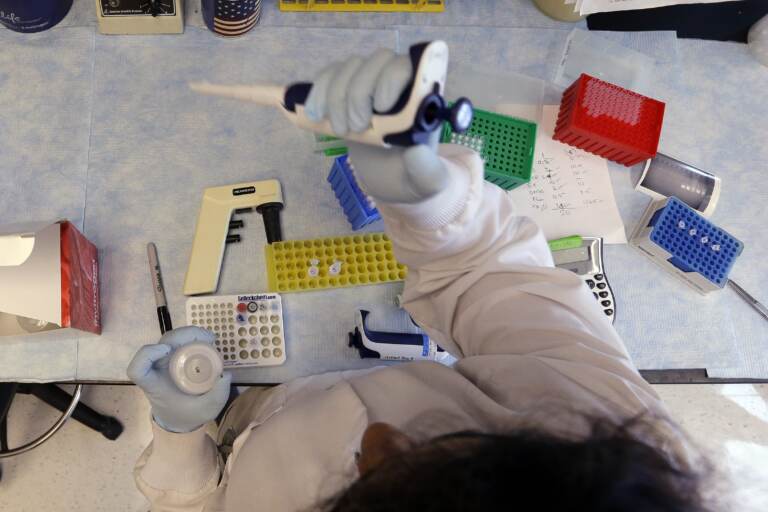
A research technician works to clone DNA in an immunotherapy research lab. (Elaine Thompson/AP Photo)
This story is from The Pulse, a weekly health and science podcast.
Subscribe on Apple Podcasts, Spotify or wherever you get your podcasts.
Sue Scott was diagnosed with cervical cancer when she was in her mid-30s. She underwent chemo and radiation, which seemed to help at first. But within months, her cancer had roared back and was spreading fast.
In the summer of 2012, a PET scan showed that tumors were squeezing against her liver, growing again on her cervix, and that a plum-sized bulge had emerged on her belly.
“I lit up like a Christmas tree,” recalled Scott. “Basically, there was disease everywhere.”
Her doctor seemed to be at a loss for words. She should enjoy her time with her family, he said. Soak up the sun on a beach trip she had planned.
“I was like, so … OK, so are you recommending a treatment though, for me? And he said, ‘Well, I mean, you know, there’s not really anything to do at this point, when it’s body-wide.’”
Realizing she might have less than a year to live, Scott began asking around about clinical trials. Through her mother’s physician, she learned Christian Hinrichs, an oncologist and researcher, was studying cancers caused by the human papillomavirus and how to attack them using a new form of immunotherapy.
In 2012, Hinrichs was leading a first-in-human cancer trial at the National Institutes of Health Clinical Center in Bethesda, Maryland. Scott called him to ask about his success rate.
“I said, ‘So, how many people are you treating?’ And he said, ‘Well, we have three right now.’”
“And I said, ‘How many of them are responding to the treatment?’ And he said, ‘Well, none yet. We don’t have anybody that’s far enough out to know whether this has worked.’”
“I’m thinking: This is the best option there is? This guy who has three patients?”
What Scott didn’t know yet was that the doctor with three patients had also been a cancer patient himself.
When Hinrichs was in his late 20s, training to be a surgeon, he noticed his vision was blurry in one eye. It turned out he had a rare eye cancer. Treatment after treatment failed, and eventually his eye had to be removed. After that, his depth perception was off, and he realized he wouldn’t be able to become a surgeon.
He went back to do another residency — this time in internal medicine — and a fellowship in medical oncology.
He has been cancer-free for many years now. But his own experience as a patient keeps him motivated to find cures.
“If my cancer were to come back, it would be fatal,” Hinrichs said. “And I wouldn’t want something that slows it down or adds weeks of survival. I would want something that completely eliminates it. Something that solves the problem and lets me go on and live my life.”
Hinrichs led cancer research trials at the NIH for more than eight years. The search for something that could eradicate cancer had brought him to immunotherapy.
Targeting the virus in virus-caused cancers
Hinrichs focused on cancers caused by the human papillomavirus, or HPV, a common sexually transmitted infection. Those cancers often appear in the cervix, genital area, head, and neck.
“The reason why they’re so intriguing is because this particular type of cancer clearly has things about it that are not human. It has viral proteins in it,” he said.
Those proteins make the cancer a target. The immune system’s T-cells notice, and attack.
In Scott’s case, Hinrichs’ team isolated some of her own immune cells that were already trying to attack her tumors — immune cells known as tumor infiltrating lymphocytes [TILs]. They were clustered around the cancer cells, punching at them, but failing to knock them out. Scott described them as “pocket protector-wearing, little, dorky, smart, but not so brawny cells.”
Scientists isolated those immune cells, turned on and activated them, multiplied them into the billions, and reinjected the cells into the patient. Now, there was an army of them, skilled, smart fighters of Scott’s particular cancer, originating from her own immune system.
Suddenly, Scott said, “they were like bouncers at 1 a.m. ‘Your time’s up, gotta go.’”
Subscribe to The Pulse
She had chemo, then got an infusion of her own cells. She stayed at the NIH for weeks, lying in bed, covered with a Wonder Woman blanket, her mom often at her side.
Her hair fell out, she battled constant nausea, and was on oxygen day and night for a while. But gradually, Scott started feeling better. Within a few weeks, she was well enough to walk out of the NIH, and go home.
A month later, scans showed her cancer had shrunk significantly. Two months later, it was gone. The treatment worked.
Another patient in the trial also got great results.
Aricca Wallace was a married mom from Kansas, also in her mid-30s, with metastatic cervical cancer, when she got into the clinical trial in summer 2012. She was patient No. 2.
“I say NIH is a place that people go when they need hope. Because most likely by the time you’ve found them, you’ve probably exhausted all other options,” Wallace said.
“They said, ‘We can’t give you any guarantees. All we can guarantee is you’re going to lose your hair.’ And I had a wig on. And I pulled it back. And I’m like, ‘Been there, done that. That doesn’t scare me.’”
A month after the treatment, Wallace felt well enough to go home to Kansas and recuperate. She came back to the NIH for scans four months later, on Dec. 19, 2012.
“We did scans, and there was no sign of disease. They were completely clear.”
Her youngest son, Marccus, was with her in the room full of doctors. He was 9 at the time.
“Marccus looked up at them and said, ‘Thanks for saving my mom.’ And at that point, there wasn’t a dry eye in the room.”
Achieving a milestone: the first cure
There were a total of nine women in that initial study. The other seven didn’t respond as well. Their cancers continued to grow, and they eventually died.
By 2018, Scott and Wallace had both reached a milestone: five years cancer-free. Some in the medical community consider that means a person is cured.
The trial marked the first cure of cervical cancer using immunotherapy.
That winter, Hinrichs hosted a small reunion at the NIH, with Scott, Wallace, and another survivor, who had enrolled in a previous clinical trial and recovered from head and neck cancer.
They talked about regaining their lives, after cancer. About their health, their careers, going fishing, raising children.
Then in walked one of Hinrichs’ newest patients, Bernie Pipan, a vice president of corporate accounts at a drainage pipe company in Ohio. Pipan shook hands with the other survivors and asked how long they’d been free of cancer.
“So I’m kind of like the product of you?” he asked, as they all laughed.
Pipan, too, was making a dramatic recovery from cancer that had spread throughout his body. He had been diagnosed with late-stage anal cancer in his 50s, after ignoring some symptoms and warning signs. By the time he found his way to the NIH, in summer 2017, cancer had spread to his lungs, bones, and one of his kidneys.
Chemo, radiation, and another type of immunotherapy had all failed. His lungs were filled with tumors, so many that doctors weren’t sure he’d meet the criteria for the study. He needed to be healthy enough to withstand the treatment.
Pipan was determined to get in. He rode an exercise bike, posed for pictures at the gym with his wife of 30 years, Joan, and showed those pictures to Hinrichs.
“And I said, ‘I know my pulmonary function is horrible. You have told me quite a bit, so I get that, and I know there is a lot of bad stuff going on inside my body. And I understand that, too. But I want you to know there is a lot of heart here, and I believe in the clinical trial,’” Pipan said.
“I believe in what you are doing here. And when you write your book on your success stories, I want to be in your book.”
Pipan became patient No. 5 in a first-in-human trial that was researching how a person’s immune cells could be genetically engineered to recognize and target cancer. This next-generation process used just a blood sample, instead of isolating immune cells that were attacking the tumor.
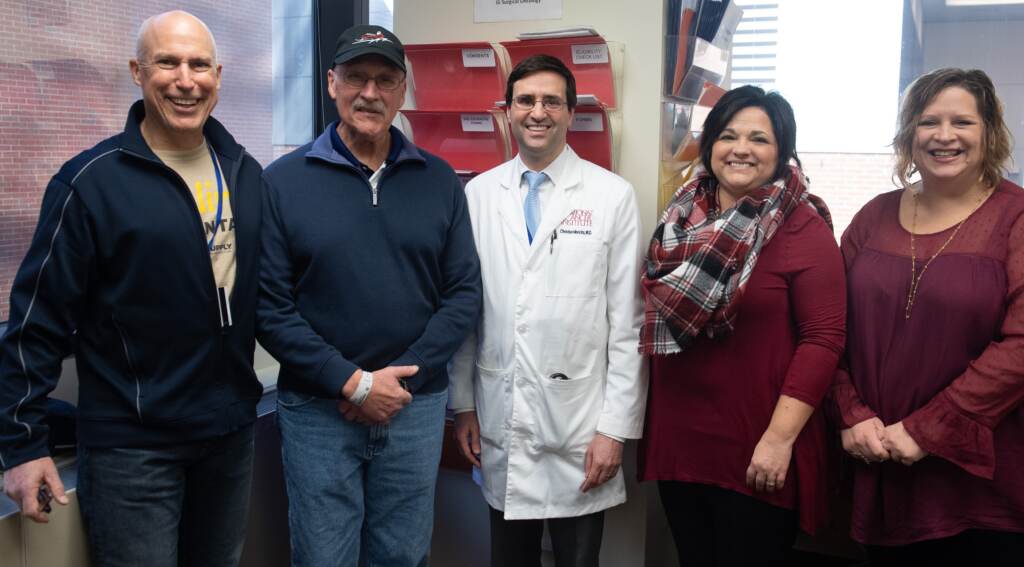
He was injected with 10 billion genetically engineered T-cells, able to recognize and target an HPV protein called E7 in his cancer cells.
Two months later, his doctors were stunned at what they saw.
Pipan’s tumors — more than 100 of them throughout his chest and midsection — had almost entirely disappeared.
Hinrichs recalled, “looking at these X-rays and just being nearly knocked out of my chair by all of the cancer that was gone.”
At his side was Scott Norberg, an assistant research physician at the National Cancer Institute.
“Yeah, I remember sitting at the desk and opening the scans with him, and we actually thought it was a different patient because it was just so dramatically different.” Norberg said.
“This is one of the first studies to show that this type of therapy can be effective in a common type of cancer, and that specifically is HPV-associated cancers,” Norberg said.
The treatment worked for six of the 12 patients in the study.
Three, including Pipan, had dramatic responses. Their cancers mostly went away, and stayed away for up to nine months.
Pipan entered the clinical trial in July 2017. By autumn, he was feeling good. No more coughing, far less chest pain than before, and he’d regained 12 pounds of lost muscle mass.
“It was very hopeful,” said his wife, Joan. “The doctor said his lungs were fairly clear, and he had a lot of good things happening. The tumor in his kidney hadn’t grown. And we thought, wow, maybe this is … maybe this is the cure.”
But there were some lingering concerns.
“Around December at a Christmas party, he noticed his tongue wasn’t working correctly,” she said.
By March 2018, new tumors were found in the bones of his neck. Pipan died in December 2018, at age 60.
Being a survivor of cancer himself, Hinrichs said, delivering the news that the treatment was no longer working was hard.
“Of course, you become attached to each patient. I’m not thinking about how to remain at a distance, I’m just thinking about how to cure them and hoping and maybe even thinking that I may have a way,” said Hinrichs, who is currently chief of the Cancer Immunotherapy Section at Rutgers Cancer Institute of New Jersey.
“When it doesn’t work, it is frustrating, and I take it personally. I do end up feeling even more the sense of urgency and the motivation to do better,” he said. “I don’t know if this makes me the best scientist or doctor, but I do get highly invested in each patient, and I take the outcomes personally. I have had colleagues tell me you can’t take it so personally. But I do. And that’s OK.”
Sorting out what worked, and why
Hinrichs and his team have spent years studying what happened, why cancer came back in patients like Pipan. They published a research letter describing their findings early this year, in the journal Nature Medicine.
They found that the treatment worked for a while because the immune cells did kill the tumors that contained viral proteins from the human papillomavirus. But then, new cells grew in other places. And those cells, in a very sneaky way, mutated to stop showing the immune system their viral proteins.
The tumors disguised themselves to avoid the very targeted immune cells that had been killing them off — almost as if the cancer learned exactly how to hide, so it could keep growing.
Researchers still aren’t sure if the tumors grew resistance to the genetically engineered T-cells in this study, or if they had grown more complex and difficult to treat because of earlier immunotherapies that had failed in these patients.
It all made Hinrichs wonder:
“If we were able to treat these patients earlier in their disease course, when there is less opportunity for resistant tumor cells to develop, would we have a much better chance of curing them? Bernie [Pipan] had about 100 tumors, and that might just be a very difficult situation to cure a patient.”
Marcela Maus, director of cellular immunotherapy at Massachusetts General Hospital’s Cancer Center, said one way to understand this is by thinking of how the coronavirus, left unchecked, can mutate.
“The only way you can get more mutations and more escapes and more variants is if the virus is continuing to replicate. So in a way, it is a similar thing with cancer. The less cancer that is there and the earlier that it is in treatment, the more responsive it is. Because there are just fewer variants out there,” she said.
Maus is also an assistant professor of medicine at Harvard Medical School, and was not involved in Hinrichs’ research.
Though immunotherapy has seen major successes against cancers of the blood, such as leukemia, “we haven’t seen those types of responses or even these kinds of trials yet in solid tumors,” added Maus.
That’s why she described Hinrichs’ research as “really exciting.”
“And I think Dr. Hinrichs and his team did a really amazing job in terms of trying to understand what the mechanisms of resistance were in the patients,” she added.
Understanding what worked, and what didn’t, helps move the science forward. One patient in the E7 trial is still alive, and doing well. Although Pipan and 10 others in the trial eventually died of cancer, their participation is helping others.
First by showing the process of injecting genetically engineered T-cells was safe. And second, by showing it had some effect. It could work.
Although Joan Pipan wishes her husband had been cured, she said they had no regrets about participating in the trial.
“It did help him. It gave him six months of quality,” she said.
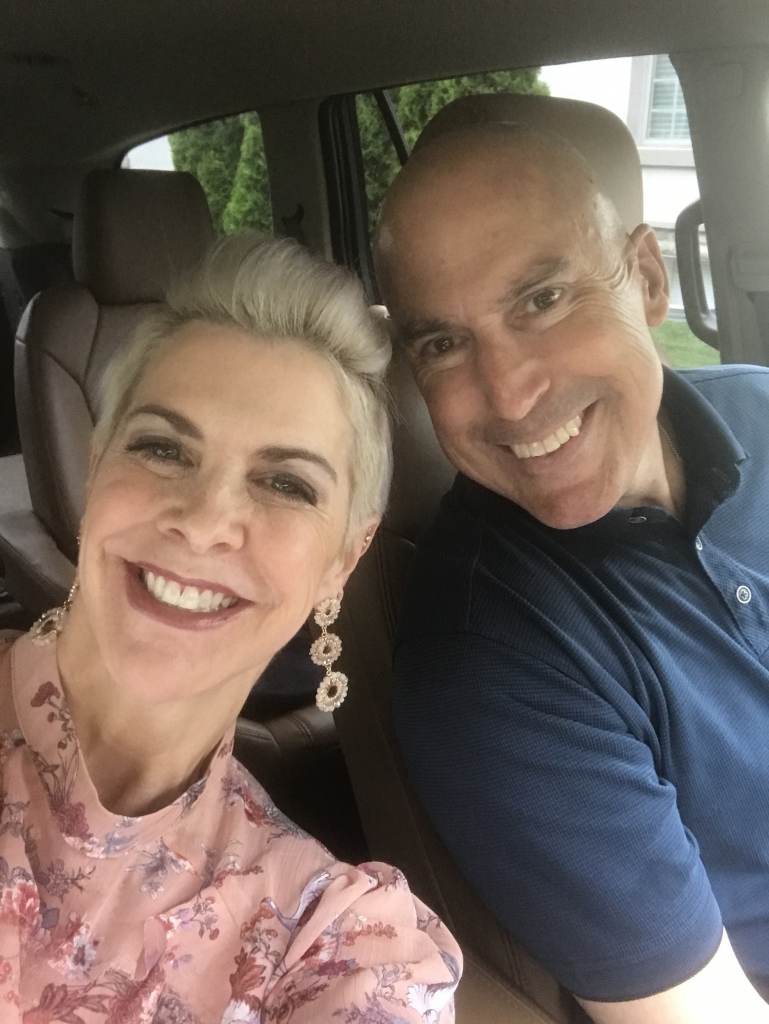
“He didn’t want to die in vain. He wanted them to learn. Learn from it! So somebody else doesn’t have to go through it.”
A Phase Two trial on the E7 receptor — targeting the viral protein in HPV cancers — is already underway.
Hinrichs is also working on a trial that would test the approach in patients who are in the early stages of HPV-driven head and neck cancers.
Looking back at what worked in the TIL trial, researchers found that Aricca Wallace’s immunotherapy was successful because her immune cells were attacking mutations that were specific to her tumor. A pharmaceutical company has picked up on the TIL therapy, and is testing it in more patients with advanced cervical cancer.
And there’s more research being done on Sue Scott’s treatment too. Hinrichs and his lab looked at her immune cells and found that many — about two-thirds of them — had targeted a specific protein called KK-LC-1. It’s also found in a number of common cancers of the breast, stomach, lung and cervix. It’s possible that what helped Scott beat cancer could help many other people. A clinical trial is expected to start soon.
Hinrichs said he would like to see the field of research move with a sense of impatience and urgency. He wants more people to seek out clinical trials, and to do it early in the course of their illness. He’d also like to see the whole field of research speed up.
“You know, if my cancer were to come back, I would be concerned about the safety of an experimental treatment. But what I would really be concerned about is if the treatment would work, and the 100% chance of dying from the cancer,” Hinrichs said.
“This is something that my patients say to me all the time, too, and we really need to take it into account and figure out how to do faster, better cancer research.”
Hinrichs knows what every cancer patient wants. They want their cancer gone. They want another chance at life. They want progress to happen fast.
WHYY is your source for fact-based, in-depth journalism and information. As a nonprofit organization, we rely on financial support from readers like you. Please give today.
